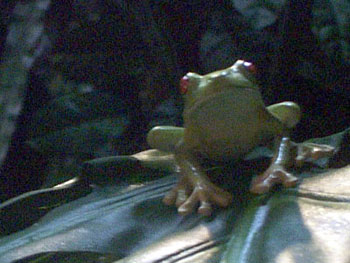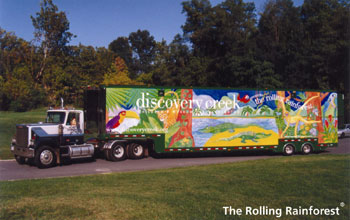Rolling Rainforest
Air Date: Week of December 13, 2002
Students in Washington, DC are getting a chance to visit the rainforest – it’s right in their school parking lot. Living on Earth followed students at the Brent Elementary School as they forayed into the jungle.
Transcript
[SOUNDS OF BIRDS]
CURWOOD: It’s Living On Earth. I’m Steve Curwood. The sights, sound, smell and feel of a tropical rainforest are neatly packed into a 48-foot trailer parked here outside the Brent Elementary School in Washington, DC.
[SOUNDS OF BIRDS]
CURWOOD: This is the Rolling Rainforest, an ecological recreation of an equatorial habitat. It’s designed by the Discovery Creek Museum to transport school kids deep into the jungle without having to leave their neighborhood.
CHILD 1: We have antibacterial wipes. We have sunscreen…
CHILD 2: You have to be clean.
CHILD 1: And insect repellent.
CURWOOD: The kids are split into groups and they’re all pretending to be different kinds of scientists.
TEACHER: All right, entomologists, I want you guys to get ready right here.
CURWOOD: We’re following three young would-be entomologists who have received a letter requesting help from a Dr. Bea Von Trapp. The good doctor studied this rainforest ten years ago and she wants the kids to tell her how many of the bugs she identified back then are still around today.

A red-eyed tree frog in the Rolling Rainforest.
(Photo: Jeff Van Ness)
TEACHER: So the first step is what?
CHILD 2: Remove all three pitfall traps from the holes in the ground.
TEACHER: Exactly, so that’s your first step.
CHILD 2: Ew! (Laughs) It’s just a bug.
CHILD 1: Can I see it? See the tweezers.
CHILD 1: The first one we gotta identify. It’s green, has light green spots and six legs.
CHILD 2: Six legs?
CHILD 3: Let me see it again. Let me see the bug again.
CHILD 1: It looks like this.
CHILD 3: There it is.
CHILD 1: Can somebody hold the bug with the tweezers?
CHILD 2: I’ll hold it.
CHILD 1: Ew.
CHILD 3: It’s just fake.
CHILD 1: I know it’s a piece of plastic.
CHILD 2: Piece of plastic that looks real.
CHILD 1: Oh, we gotta pretend.
CHILD 3: Okay.
CHILD 1: What was the name of it?
CHILD 2: Starchichbidi something.
TEACHER: That’s a really hard name to pronounce. It’s scaribiadi. Can you say that?
CHILDREN: Scaribiadi.
TEACHER: And all those names are Latin names for the kinds of insects.
CHILD 2: It has one on this one too.
TEACHER: Yes, there’s a lot of different kinds….
[SOUND OF CHILDREN IN CLASSROOM]
TEACHER: Do you remember how many different bugs you guys found?
CHILD 3: Ten.
CHILD 2: Ten.
CHILD 1: I think twelve.
TEACHER: Twelve or so?
CHILD 3: We found ten.
TEACHER: Did you guys compare it to what the scientists found ten years ago?
CHILDREN: Yeah, it was 112-something.
TEACHER: Well, wait, the scientists ten years ago found over a hundred bugs?
CHILDREN: Uh-huh.
TEACHER: And you guys found around 10 or so?
CHILD 3: Yes.
TEACHER: What could have happened to the environment that made such a difference?
CHILD 2: It probably got eaten.
TEACHER: Maybe they got eaten. Who's eaten them?
CHILD 2: The animals. Bigger animals.
TEACHER: What else could happen?
CHILD 3: The amount of food.
TEACHER: What about the amount of food?
CHILD 3: Well some of the plants could have extinct.
TEACHER: That’s true, maybe their food source is leaving.
CHILD 1: Maybe they got drowned.
TEACHER: Actually now why does it matter? Why are we studying bugs in the rainforest?
CURWOOD: Indeed that question would come up again when our fledgling entomologists met their fellow kid hydrologists, ichthyologists-- that’s fish scientists, in case you wondered-- and soil scientists back in the classroom. The students talked about how the rainforest ecosystem is connected to the environment in their own schoolyard and how they rely on the rainforest for things like oxygen and medicine.
One question didn’t get answered though.
CHILD 1: Is there really a Dr. Bea Von Trapp?

(Photo: Discovery Creek)
CURWOOD: The Rolling Rainforest will visit 15 more schools in Washington, DC, before rolling on to New York and California next year.
[CLASSROOM TALKING]
TEACHER: Because there’s fewer species.
Links
Living on Earth wants to hear from you!
Living on Earth
62 Calef Highway, Suite 212
Lee, NH 03861
Telephone: 617-287-4121
E-mail: comments@loe.org
Newsletter [Click here]
Donate to Living on Earth!
Living on Earth is an independent media program and relies entirely on contributions from listeners and institutions supporting public service. Please donate now to preserve an independent environmental voice.
NewsletterLiving on Earth offers a weekly delivery of the show's rundown to your mailbox. Sign up for our newsletter today!
 Sailors For The Sea: Be the change you want to sea.
Sailors For The Sea: Be the change you want to sea.
 The Grantham Foundation for the Protection of the Environment: Committed to protecting and improving the health of the global environment.
The Grantham Foundation for the Protection of the Environment: Committed to protecting and improving the health of the global environment.
 Contribute to Living on Earth and receive, as our gift to you, an archival print of one of Mark Seth Lender's extraordinary wildlife photographs. Follow the link to see Mark's current collection of photographs.
Contribute to Living on Earth and receive, as our gift to you, an archival print of one of Mark Seth Lender's extraordinary wildlife photographs. Follow the link to see Mark's current collection of photographs.
 Buy a signed copy of Mark Seth Lender's book Smeagull the Seagull & support Living on Earth
Buy a signed copy of Mark Seth Lender's book Smeagull the Seagull & support Living on Earth

